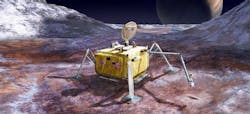NASA explores autonomous surface missions on 'ocean worlds'
WASHINGTON - Through advanced autonomy testbed programs, NASA is setting the groundwork for one of its top priorities—the search for signs of life and potentially habitable bodies in our solar system and beyond. The prime destinations for such exploration are bodies containing liquid water, such as Jupiter’s moon Europa and Saturn’s moon Enceladus. Initial missions to the surfaces of these “ocean worlds” will be robotic and require a high degree of onboard autonomy due to long Earth communication lags and blackouts, harsh surface environments, and limited battery life, NASA writes. Continue reading original article.
The Military & Aerospace Electronics take:
5 December 2024 - NASA has been advancing spacecraft autonomy through AI-driven technologies like machine learning and causal reasoning. To support future ocean world missions, it developed the Ocean Worlds Lander Autonomy Testbed (OWLAT) at JPL and the virtual OceanWATERS platform at Ames Research Center. Programs like ARROW (2020) and COLDTech (2021) funded six U.S.-based teams to create and test autonomy solutions on these testbeds. OWLAT simulates a spacecraft lander equipped with a seven-DOF robotic arm, sensors, and a camera to mimic low-gravity operations, enabling dynamic behavior akin to real-world missions. These projects have addressed challenges for autonomous exploration of icy moons.
Related: DARPA seeks to enable machine autonomy for safety-critical aircraft applications
Jamie Whitney, Senior Editor
Military + Aerospace Electronics
